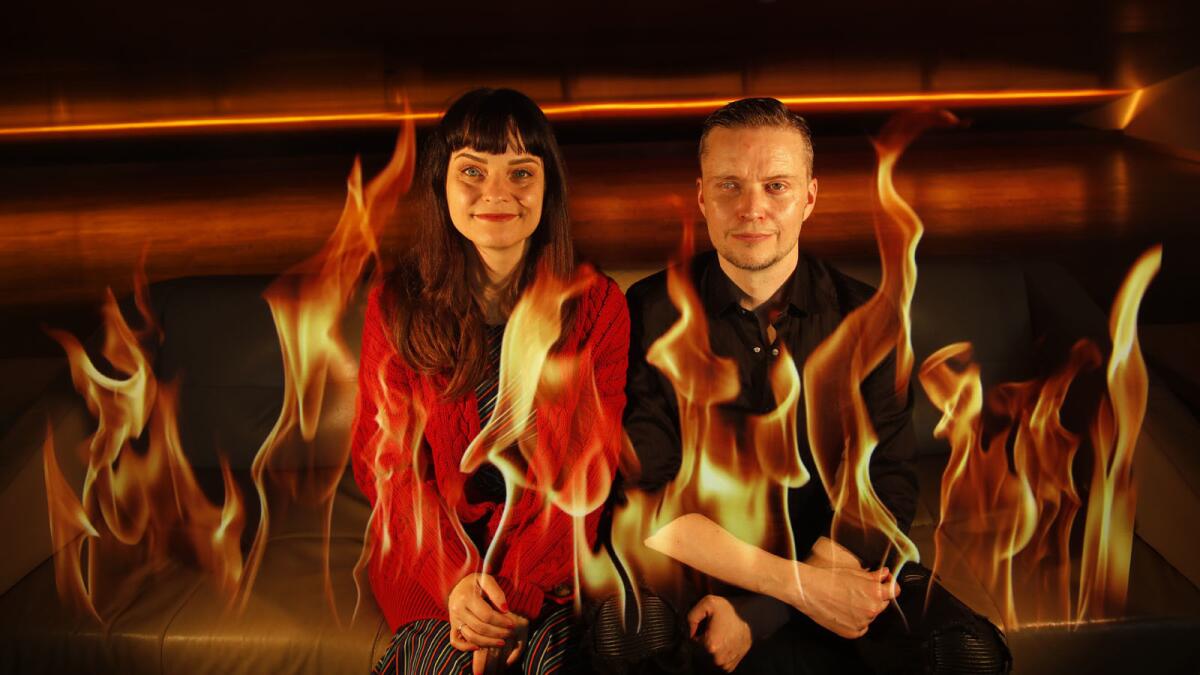‘Hail Satan?’ profiles group that takes its inspiration from ‘the original troll’

Reporting from New York — If you want to be left alone during brunch at a hipster Brooklyn café, start talking out loud about Satanism, black masses and a movie called “Hail Satan?”
“The only ‘canonical’ black mass is one written by Catholics imagining everything that they would think was heretical,” said filmmaker Penny Lane, over eggs. “There’s not a tradition of devil worshipers doing black masses. There’s a tradition of hallucinated fear.”
(Can we get some coffee over here? No?)
On a bright Sunday morning in the Borough of Churches, Lane discussed her latest documentary, which is now playing in limited release and examines the works, beliefs and tactics of the Satanic Temple, a consortium of devoted nonconformists who follow what one interviewee dubs “the original troll” — Satan, a.k.a. Lucifer, Mephistopheles, Beelzebub, the Antichrist, the Devil and the prototypical antihero of English literature courtesy of John Milton.
The question mark in the title of “Hail Satan?” — which wasn’t always there — punctuates a question raised by the film: Can Satanists be taken seriously? Or are they just trolling?
Review: Penny Lane’s ‘Hail Satan?’ offers cheeky insight into the Satanic Temple »
“You have to say both,” Lane said, “and that was always the attraction for me. Yes, they’re kidding. And yes, they’re serious. Those things are both true, or else you can’t understand the phenomenon. If you want to look at them just as jokers, you’re not actually paying attention to what’s going on.”
As Lane tells us in the film, what’s been going on with the Satanic Temple — which is led by Lucien Greaves (not his real name) and headquartered in an all-black house in Salem, Mass. — is “more than just a middle finger to the evangelical right,” according to Greaves. But it’s still the stuff of right-wing nightmares:
In Florida, the Satanic Temple threw its support behind Rep. Gov. Rick Scott (who won reelection in 2013 anyway).
At the Oklahoma State Capitol, Satanists helped prevent the erection of a Ten Commandments monument by insisting (on constitutional grounds) that their statue of the goat demon Baphomet deserved equally prominent placement on government property.
In Little Rock, Ark., the Satanic Temple won its suit against the erection of another Ten Commandments tablet, again by arguing pluralism and church versus state (an appeal is in the works).
And they’ve trolled the Westboro Baptist Church by taking a cue from the Church of Latter-day Saints and performing a post-mortem conversion of minister Fred Phelps’ mother to lesbianism (while performing lewd acts at her grave).
But as Lane presents, they’ve also performed a number of what the conventionally religious would ordinarily call “good works.” After-school programs for kids; something called “Menstruation for Satan,” which provides free hygiene products to homeless women; and the adoption of stretches of highway that members keep tidy, following the lead of companies like McDonald’s or Merrill Lynch.
Lane, whose films include “Our Nixon” (based on the home movies of the president’s aides) and “Nuts!” (about testicles and quackery), said that the disposition of Satanic Temple members is basically Marxist, as in Groucho (“I don’t want to belong to any club that would have me as a member”). Which makes holding an organization together rather fraught.
“There’s a kind of individualism and sense of personal autonomy at the Satanic Temple that appeals to people who’ve felt like outsiders all their life,” said Greaves. “But I don’t see it as paradoxical that we organize the way we do, and defend our rights the way we do.”
They don’t proselytize, he said; people come to them. “It’s amazing to me how quickly that conversion can happen,” he said. “I was giving a lecture in Salt Lake City and was approached by a young man who’d been on his church mission when he watched some YouTube videos I was in, and he ended up deciding that Satanic Temple made a lot more sense.”
For Lane, “Hail Satan?” marks the first time that a film she made involved “things that were actually happening” rather than being totally archival, like the Nixon film. At the same time, there is a lot of archival material, including the history of satanism in America and excerpts from TV news shows in which the Satanic Temple is either used for “wacky human interest” or simply vilified by the most rightward of Christian authorities. Of course, even liberal Catholic thinkers have a problem with the Prince of Darkness.
“It’s hard to presume good intentions of a group called the Satanic Temple, frankly. I’m not sure what would prompt them to take as their namesake Satan, but, needless to say, he isn’t about doing good deeds,” said Father James Martin, S.J., editor at large at America magazine and a consultant to the Vatican’s Secretariat for Communications. “If you want to confront the religious right, for example, there are other ways to do so. The irony is that they seem to be assuming that you can’t be a Christian if you disagree with the far right. Of course you can, and you can worship Jesus at the same time.”
But it really does have to be Satan, said Greaves. “That’s been one of those things that’s been hardest to define for people who aren’t on board with this,” he said, “until they see how we contextualize Satan and it makes so much more sense to them. The metaphor of the heroic outsider-rebel has a real resonant meaning, even though it’s not literal or the veneration of a personal Satan.”
Lane feels a personal affinity for the folks in the Temple, she said, having never been a part of any organized religion and being temperamentally disinclined to join groups. And the subject fit snugly in her oeuvre.
“For me, it’s part of an ongoing sort of intellectual pursuit,” she said. “It might not be true of everything I’ve ever done, but if you look back over the 17 years that I’ve been doing films, I have always been kind of interested in nonfiction and largely because it lets you deal with issues of belief and truth. Right? So a lot of my films are about people who believe certain things. And trying to figure out what made them believe it.”
More to Read
Only good movies
Get the Indie Focus newsletter, Mark Olsen's weekly guide to the world of cinema.
You may occasionally receive promotional content from the Los Angeles Times.










